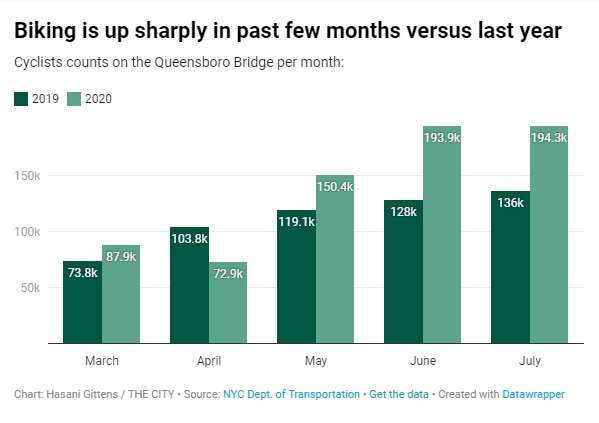
Cyclists ride over the Queensboro Bridge, Aug. 3, 2020. Ben Fractenberg/THE CITY
By Jose Martinez, THE CITY
This story was originally published on 8/5/20 by THE CITY
Even with many New Yorkers staying home during the pandemic, growing legions of bicyclists are pedaling over the city-run East River bridges that link Queens and Brooklyn to Manhattan.
“It can get pretty tight up there at times,” Andre Figueroa, 19, of Astoria, said before riding into Manhattan over the Queensboro Bridge’s shared cyclist and pedestrian path. “Ever since the start of this pandemic, you’ve seen a real change when it comes to people bicycling.”
City Transportation Department data shows that the average number of bicycle trips across the Queensboro, Williamsburg, Manhattan and Brooklyn bridges are generally up over last year — with 20% hikes in June and July alone.

Jose Martinez/THE CITY Andre Figueroa, Aug 3, 2020
But the economic crisis that grew out of the global pandemic is causing the DOT to pump the brakes on efforts to ease congestion on the shared foot-and-bike paths on the Queensboro and Brooklyn bridges, according to a letter sent to cycling advocates and obtained by THE CITY.
The July letter from Eric Beaton, a deputy commissioner at the DOT, notes the current space for cyclists on the East River bridges is “not ideal” and describes the paths as “pinch points in the cycling network.”
But, he wrote, “alterations are too extensive to pursue immediately, given the city’s current fiscal crisis.”
‘It’s Packed’
Advocates and elected officials have long been pushing for more space for cyclists on the Queensboro Bridge’s shared path, as THE CITY reported last year.
“It’s packed,” said Laura Shepard a bike network organizer at Open Plans, an advocacy nonprofit. “You’ve got people walking and biking in both directions, a full range of people commuting, jogging, on pedal bikes, e-bikes and some of the smaller scooters.”
Beaton’s letter added that the department “agrees” that the Queensboro Bridge’s south outer roadway, now limited to motor vehicles, should be converted into a bike-only space, allowing the shared path on the north side of the bridge to be used only by pedestrians.
That would require, the letter said, adding “tall, secure fencing” to the south outer roadway to prevent cyclists or pedestrians from jumping or falling over the side, and to keep people from dropping anything into the East River.

As part of ongoing work on the bridge’s upper roadways, which is expected to last until 2022, Beaton wrote that the DOT hopes to make the south outer roadway “safe and functional for cyclists and pedestrians in coordination with the larger bridge reconstruction.”
“We recognize this delay is disappointing and if the fiscal circumstances change and we are able to accelerate that timetable, we will certainly do so,” the letter reads.
Brooklyn Bridge Blockage
Department of Transportation data shows bicyclists took 194,305 trips across the Queensboro Bridge in July, nearly 60,000 more than the same period last year.
That’s slightly up from the 193,944 bicycle trips along the bridge in June, an increase of nearly 66,000 from the same time in 2019. May brought 150,359 cycling trips on the Queensboro, up by more than 30,000 from the previous year.
In April, with many New Yorkers sheltering in place, there were 72,935 cycling trips, down from 103,843 in 2019.
Overall, May bike trips across the East River spans increased slightly over the previous year, following a 42% drop in April amid Gov. Andrew Cuomo’s stay-at-home order.
The boost in cycling comes as subway and bus trips, as well those in as yellow cab and for-hire vehicles, have plummeted.
Plans to potentially widen the shared foot-and-bike path on the Brooklyn Bridge had already run into “financial challenges” in the last couple of years, Beaton wrote, noting that bids to evaluate the iconic bridge cables as the first step in the project were “prohibitively high.”
“And now, with the city facing tremendous budget shortfalls, that project is even more challenging,” he wrote.
The Brooklyn Bridge’s congested shared promenade, a favorite with tourists in pre-pandemic days, was crossed by 60,181 cyclists in July, DOT records show. That marked a decline from the 66,625 trips in July 2019, but bridge users are still careful when traversing the narrow passage.
“It’s noticeable how many more normal bikes and electric bikes are on the path before the pandemic, then you have the pedestrians who walk next to each other,” said cyclist Ricardo Arias, 54, of Corona. “You have to be careful on the path.”
This story was originally published by THE CITY, an independent, nonprofit news organization dedicated to hard-hitting reporting that serves the people of New York.
6 Comments

Four people at once in a NYC bike lane picture – a record!
Hey genius, if you scroll down, you’ll see another picture of a chart, and it says over 194,000 people crossed the bridge on a bike in July alone.
So what? Even that data doesn’t support this argument. With 31 days in July that means 6258 trips a day. If you divide that by 10 hours that equals 625 trips an hour per day. That’s 10 trips per minute. If you space it out over 12 to 14 hours a day that means fewer trips per hour. Those complaining should take the subway. They are cleaner and have air conditioning.
Stop whining. Bike lanes are for the fixie hipster transplants. Just ride with the cars over the bridges. Toughen up. Quit relying on government to make your life easier.
How many hipster transplants 54 yrs old living in Corona?
Do work for the Census Harry?